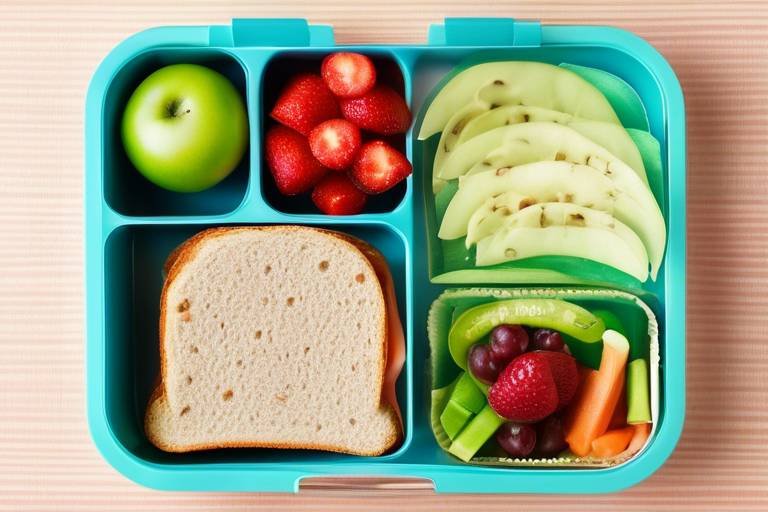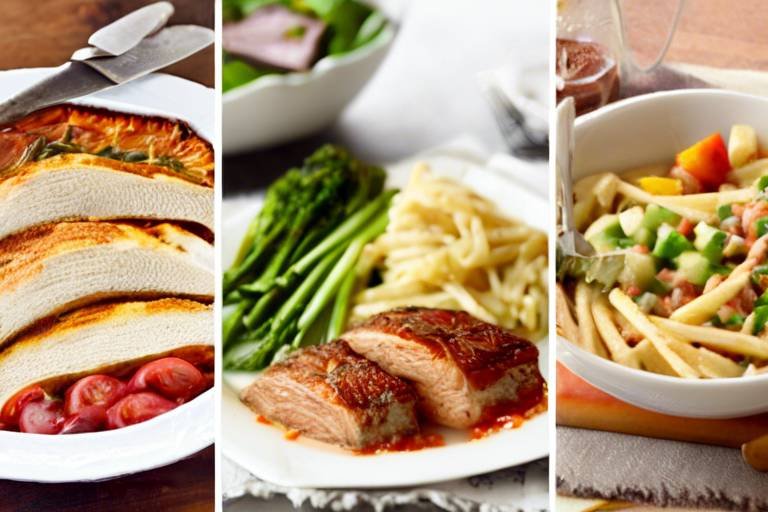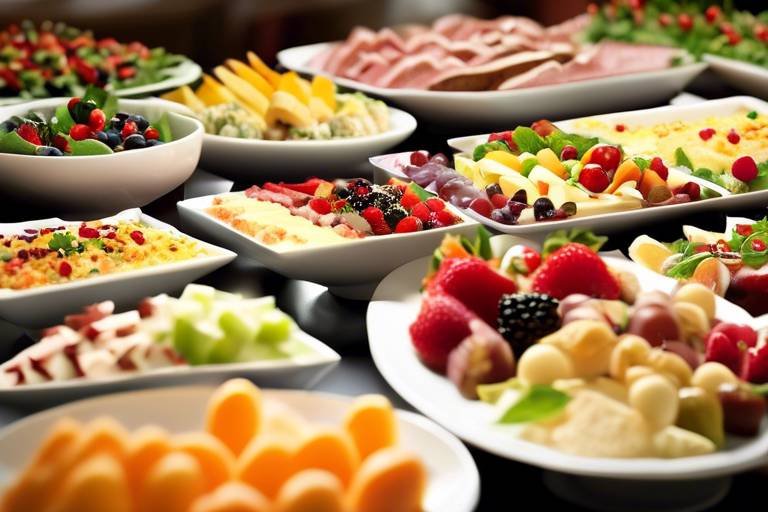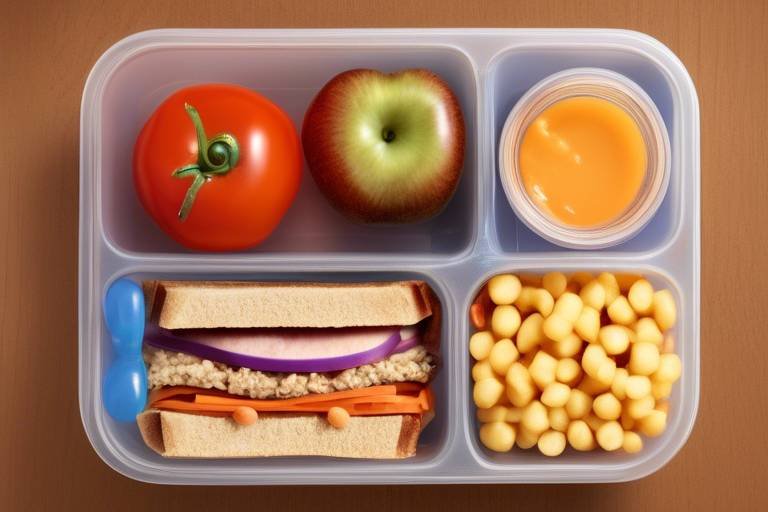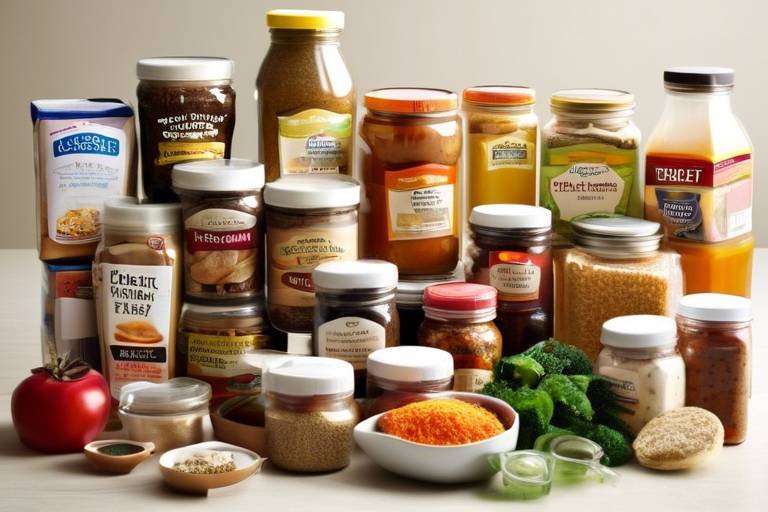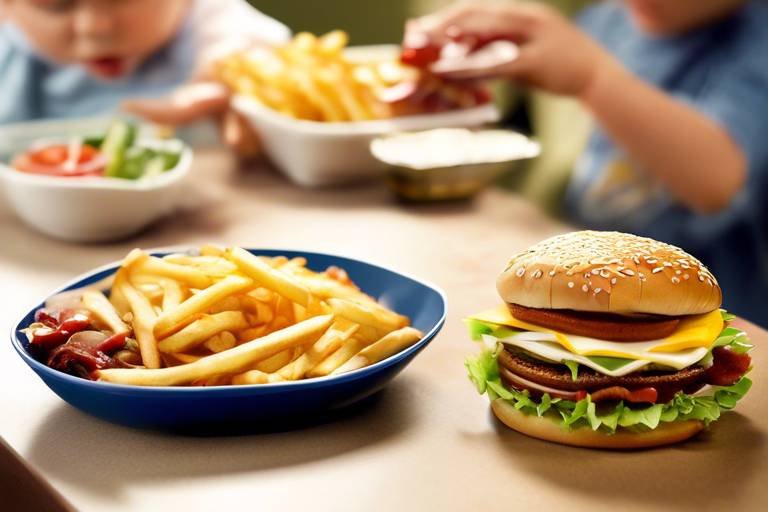Fun Ways to Teach Kids About Nutrition
Teaching kids about nutrition can be a delightful adventure! It's not just about lecturing them on what to eat; it's about making the learning process engaging and interactive. Imagine your child, eyes wide with curiosity, as they mix ingredients in a bowl or dig their hands into the soil of a garden bed. The goal is to foster a love for healthy eating that lasts a lifetime, and the best way to do that is through fun activities that ignite their imagination.
In today's world, where fast food and sugary snacks are everywhere, instilling a sense of healthy eating in children is more crucial than ever. By utilizing creative methods, we can teach them about nutrition in ways that resonate with their playful spirits. From cooking classes to gardening and even fun games, there are countless avenues to explore. Let's dive into some of these exciting ways to turn nutrition education into a joyful experience!
Cooking classes can be a fantastic way for kids to learn about nutrition. Hands-on experiences in the kitchen help children understand ingredients, portion sizes, and the importance of balanced meals while having fun. Picture this: your child standing on a stool, eagerly stirring a pot of colorful vegetables. They are not just cooking; they are discovering the vibrant world of food!
In these classes, kids can learn to prepare simple, nutritious meals. They can explore various food groups, understand where their food comes from, and even get creative by inventing their own recipes. This not only boosts their confidence but also instills a sense of responsibility towards their food choices.
Gardening allows children to connect with their food sources. Planting and caring for vegetables and herbs teaches kids about nutrition, the growth process, and the benefits of fresh produce in their diets. Imagine the excitement of watching a tiny seed sprout into a lush plant right before their eyes! It's like magic, but it's all science and nature.
Establishing a vegetable garden can be a rewarding project. Kids learn responsibility while discovering the nutritional value of homegrown vegetables and the joy of eating what they have cultivated. They can plant a variety of vegetables such as tomatoes, carrots, and cucumbers, and as they grow, they can learn about the vitamins and minerals each one provides.
Planting herbs is an excellent way for kids to explore flavors and nutrition. They can learn about different herbs' culinary uses and health benefits while developing a green thumb. Imagine them growing basil, mint, or rosemary, and then using those fresh herbs to enhance their meals. It’s a sensory experience that ties together gardening, cooking, and nutrition in a delightful package!
Games can make learning about nutrition enjoyable and memorable. Incorporating quizzes, scavenger hunts, and board games can engage children, reinforcing their understanding of healthy eating habits. Who said learning has to be boring? With the right games, kids can absorb important nutritional information while laughing and having a blast!
Nutritional Bingo is a creative game that can teach kids about various food groups. Players match food items on their cards, learning to identify healthy options while having fun with friends and family. Just imagine the excitement as they shout "Bingo!" and share what they’ve learned about the foods they matched!
Organizing a scavenger hunt for healthy foods encourages kids to explore. They can learn about different fruits and vegetables while searching for healthy items in their homes or local grocery stores. It’s an adventure that combines physical activity with nutrition education, making it a win-win!
Transforming food into art can spark children's interest in nutrition. By creating fun and colorful food designs, kids can learn about healthy ingredients while expressing their creativity. This not only makes eating healthy exciting but also encourages them to try new foods!
Sculpting with fruits and vegetables can be an exciting activity. Children can create fun shapes and characters, making healthy eating visually appealing and encouraging them to try new foods. Think of it as a delicious art class where the end result is not just a masterpiece but also a nutritious snack!
Plate design challenges inspire kids to create visually appealing meals using various healthy ingredients. This activity promotes creativity while teaching the importance of balanced nutrition in an enjoyable way. They can learn about colors, textures, and flavors, all while making their meals look like a work of art!
- How can I get my child interested in cooking? Start with simple, fun recipes that allow them to get hands-on. Involve them in meal planning and shopping to pique their interest.
- What are some easy vegetables to grow with kids? Consider starting with fast-growing options like radishes, lettuce, or herbs like basil and mint.
- How can games help with nutrition education? Games make learning fun and interactive, helping kids retain information better while enjoying the process.
- What if my child is a picky eater? Encourage them to try new foods by involving them in the cooking and preparation process. Present food in fun and creative ways!

Interactive Cooking Classes
Cooking classes can be a fantastic way for kids to learn about nutrition. Imagine the excitement on their faces as they don their little aprons, ready to dive into the world of flavors and healthy ingredients! Hands-on experiences in the kitchen not only make learning fun but also help children understand essential concepts such as ingredients, portion sizes, and the importance of balanced meals. It's like turning the kitchen into a mini-laboratory where every ingredient has a story to tell.
In these interactive cooking classes, kids can engage in various activities that are both educational and entertaining. For instance, they can:
- Learn how to read nutrition labels, turning them into little detectives searching for healthy choices.
- Experiment with different cooking methods, such as steaming, roasting, and sautéing, to discover how these techniques can enhance the flavor and nutritional value of food.
- Explore the concept of food groups by creating colorful plates that represent a rainbow of nutrients.
One of the most enjoyable aspects of these classes is the chance to get creative. Kids can whip up their own recipes, choosing ingredients that not only taste good but are also packed with essential vitamins and minerals. This hands-on approach fosters a sense of ownership over their meals, making them more likely to try new foods and develop a love for cooking.
Consider organizing a fun cooking competition where kids can work in teams to prepare healthy dishes. This not only promotes teamwork but also encourages them to think critically about nutrition. They can present their dishes, explaining the nutritional benefits of each ingredient, which reinforces their learning in a fun and engaging way.
In addition to learning about nutrition, cooking classes can also teach valuable life skills. Kids learn to follow directions, measure ingredients, and practice kitchen safety. It's like giving them a toolbox filled with skills they will carry into adulthood.
So, whether you're a parent looking to instill healthy habits in your children or an educator seeking innovative teaching methods, interactive cooking classes are an excellent avenue to explore. They transform the often-daunting subject of nutrition into a delightful adventure, where kids can discover the joy of cooking while embracing a healthier lifestyle.
Q: What age group is suitable for interactive cooking classes?
A: Interactive cooking classes can be tailored for various age groups, typically starting from ages 5 and up. Younger children may need more supervision, while older kids can handle more complex tasks.
Q: Do I need special equipment for these classes?
A: While basic kitchen equipment is necessary, such as pots, pans, and utensils, many activities can be done with simple tools. It's more about creativity than having a fully stocked kitchen.
Q: How can I find cooking classes for kids in my area?
A: Check local community centers, cooking schools, or online platforms that offer virtual cooking classes. Many organizations have adapted to offer engaging online sessions!

Gardening Activities
Gardening is not just a hobby; it’s a fantastic way for kids to connect with their food and understand where it comes from. Imagine the excitement on their faces when they see a seed sprout into a plant! This hands-on experience fosters a deeper appreciation for the food they eat and teaches them valuable lessons about nutrition. By engaging in gardening activities, children can learn about the growth process, the importance of fresh produce, and the benefits of incorporating these foods into their diets. It’s like giving them a backstage pass to the world of healthy eating!
One of the most rewarding projects you can embark on with your kids is creating a vegetable garden. Not only does this teach them responsibility, but it also provides them with the opportunity to discover the nutritional value of homegrown vegetables. Watching a tiny seed transform into a vibrant carrot or a juicy tomato is a magical experience that they won't forget. Plus, there’s nothing quite like the taste of a freshly picked vegetable! It’s like a burst of sunshine on their plates.
When starting a vegetable garden, consider involving your kids in every step of the process. From choosing the right seeds to planting and watering, each task can be a learning experience. You can even create a garden journal where they can document their progress, note down what they’ve learned, and reflect on their experiences. This not only enhances their understanding of gardening but also strengthens their writing skills!
Here are some simple steps to kickstart your vegetable garden adventure:
- Choose a Location: Find a sunny spot in your yard or use pots if space is limited.
- Select Easy-to-Grow Vegetables: Start with vegetables like tomatoes, radishes, or lettuce that are forgiving for beginners.
- Prepare the Soil: Teach kids about soil quality and how to enrich it with compost.
- Plant and Water: Show them how to plant seeds and the importance of regular watering.
- Harvest Time: Celebrate the harvest together! Enjoying the fruits of their labor is the best part.
Another exciting gardening activity is planting herbs. Herbs are not only easy to grow but also add flavor and nutrition to meals. Kids can learn about various herbs, their culinary uses, and health benefits while developing a green thumb. Imagine them snipping fresh basil or mint to add to a dish they helped prepare! It’s a delightful way to encourage them to try new flavors and appreciate the role of herbs in healthy cooking.
To make herb planting even more engaging, consider creating a mini herb garden indoors or on a windowsill. This way, they can observe the growth process up close. You can also have fun experimenting with different recipes that incorporate their homegrown herbs, turning cooking into a delightful family activity. It’s like a culinary adventure right in your kitchen!
In conclusion, gardening activities are a wonderful way to teach kids about nutrition in an engaging and interactive manner. By nurturing plants, they learn responsibility, the value of fresh produce, and the joy of eating healthy. So, grab some seeds, get your hands dirty, and watch as your kids blossom into little gardeners!
Q: What are the best vegetables for kids to grow?
A: Some of the easiest and most rewarding vegetables for kids to grow include radishes, carrots, cherry tomatoes, and lettuce. These plants grow quickly and can be harvested in a few weeks, keeping children engaged and excited.
Q: How can I make gardening fun for my kids?
A: You can make gardening fun by incorporating games, like scavenger hunts for different plants or creating a garden journal. Encourage creativity by letting them design their garden layout or decorate plant pots.
Q: What are the benefits of growing herbs?
A: Growing herbs not only enhances the flavor of meals but also introduces kids to the concept of cooking with fresh ingredients. Herbs like basil, mint, and parsley are easy to grow and can be used in various dishes, promoting healthy eating habits.

Creating a Vegetable Garden
Establishing a vegetable garden can be one of the most rewarding projects for kids. Imagine the excitement in their eyes as they dig their hands into the soil, planting seeds that will eventually sprout into delicious vegetables! This hands-on experience not only teaches children about the nutritional value of fresh produce but also instills a sense of responsibility and accomplishment. As they nurture their plants, they learn that good things take time and care, much like their own growth.
In a world where fast food often dominates, creating a vegetable garden is like planting the seeds of healthy habits that can last a lifetime. Kids will discover the joy of eating what they have cultivated, making it more likely that they will enjoy these foods. The process of watching their plants grow can be compared to a magical transformation, where tiny seeds become vibrant vegetables, ready to be harvested and enjoyed.
To kickstart this adventure, consider the following steps:
- Choosing the Right Location: Find a sunny spot in your yard or even a few pots on a balcony. Vegetables typically need at least 6 hours of sunlight each day.
- Selecting Easy-to-Grow Vegetables: Start with vegetables that are forgiving and grow quickly, such as radishes, lettuce, or cherry tomatoes. This will keep the kids engaged and excited as they see results sooner.
- Planning the Layout: Help your kids design the garden layout. They can draw a simple map of where each vegetable will be planted, making them feel like true garden architects.
- Caring for the Garden: Teach children about watering, weeding, and watching for pests. This is where they learn the importance of taking care of their food sources.
Additionally, you can incorporate fun facts about each vegetable they plant. For example, did you know that tomatoes are technically a fruit? Sharing such tidbits can make the gardening experience even more enriching and educational. As they harvest their veggies, encourage them to help prepare meals using their homegrown produce. This not only reinforces the connection between gardening and nutrition but also makes mealtime a special occasion.
In conclusion, creating a vegetable garden is more than just planting seeds; it's about cultivating a love for healthy eating and understanding where food comes from. It's an adventure that can spark curiosity, foster responsibility, and, most importantly, create lasting memories. So grab those gardening gloves and get ready to dig in!
Q: What vegetables are best for beginners?
A: Some of the easiest vegetables to grow for beginners include radishes, lettuce, and cherry tomatoes. These plants grow quickly and are generally low-maintenance.
Q: How much space do we need for a vegetable garden?
A: You don't need a large space! Even a few pots on a balcony can work. The key is to ensure they get enough sunlight.
Q: How can I keep kids engaged in the gardening process?
A: Involve them in every step, from planning the garden layout to harvesting the vegetables. Share fun facts and let them take ownership of their plants.

Herb Planting Projects
Have you ever thought about how much fun it is to grow your own herbs? can be an exciting way for kids to dive into the world of gardening while learning about the flavors and health benefits of various herbs. Imagine the joy on their faces when they see their little plants sprouting and thriving! Not only does this activity promote a sense of responsibility, but it also opens the door to a myriad of culinary adventures.
When kids plant herbs, they're not just digging in the dirt; they're embarking on a journey of discovery. They learn about different types of herbs, such as basil, parsley, and mint, and how each one can enhance the flavor of their favorite dishes. It's like introducing them to a secret world where food becomes a canvas for creativity. For instance, they can add fresh basil to a homemade pizza or sprinkle mint over a refreshing fruit salad. The possibilities are endless!
To kickstart an herb planting project, you can start with a simple setup. Here’s a quick guide:
| Herb | Growing Conditions | Uses |
|---|---|---|
| Basil | Warm, sunny spot | Great in pasta dishes and salads |
| Parsley | Partial shade | Used as a garnish or in soups |
| Mint | Full sun | Adds flavor to drinks and desserts |
Starting with a few pots or a small garden bed, kids can plant seeds or young plants and watch them grow. They can water them, observe their growth, and learn about the care each herb requires. This hands-on experience not only teaches them about plant biology but also instills the importance of patience and nurturing. Plus, it’s a fantastic way to get them outdoors and away from screens!
As the herbs flourish, encourage your kids to experiment in the kitchen. They can snip off fresh leaves and incorporate them into their meals, discovering firsthand how herbs can elevate flavors. It’s like a mini cooking class right at home! You might even find them creating their own recipes, blending creativity with nutrition.
In addition, herb planting projects can also serve as a springboard for discussions about nutrition. Talk to your kids about how herbs are not just flavor enhancers but also packed with health benefits. For example, did you know that basil has anti-inflammatory properties, and mint can aid digestion? By connecting the dots between gardening and nutrition, kids will develop a deeper appreciation for what they eat.
In conclusion, herb planting projects are more than just a fun activity; they are a gateway to learning about nutrition, responsibility, and creativity. So grab some pots, seeds, and a little soil, and let the gardening adventure begin!
- What are the easiest herbs to grow with kids? Basil, parsley, and mint are great starter herbs due to their fast growth and resilience.
- How much sunlight do herbs need? Most herbs thrive in full sun, requiring at least 6 hours of sunlight a day.
- Can we grow herbs indoors? Absolutely! Many herbs can be grown indoors on a sunny windowsill.

Fun Nutrition Games
Games can be a fantastic way to engage kids in learning about nutrition while having a blast! Imagine turning the often mundane subject of healthy eating into a lively adventure. By incorporating interactive elements like quizzes, scavenger hunts, and board games, children can absorb vital information about nutrition without even realizing they’re learning. It’s like sneaking vegetables into a delicious smoothie; they get the goodness without the fuss!
One of the most enjoyable ways to teach kids about nutrition is through Nutrition Bingo. This creative game transforms the traditional bingo format into a fun learning experience. Players are given cards with various food items representing different food groups. As the game progresses, they match the food items called out, which helps them identify healthy options. Not only does it promote recognition of nutritious foods, but it also encourages friendly competition among friends and family. Plus, who doesn’t love a little bingo excitement?
Another exciting game is the Scavenger Hunt for Healthy Foods. This activity encourages kids to explore their environment while learning about nutrition. Parents or educators can create a list of healthy food items, such as fruits, vegetables, and whole grains, that kids need to find either in their homes or local grocery stores. As they embark on this treasure hunt, they’ll learn about the various benefits of these foods. It’s a perfect blend of physical activity and education, making healthy eating a thrilling quest!
To make it even more engaging, consider incorporating team-based challenges. For instance, you could divide kids into teams and have them compete to see who can find the most items from the healthy food list the fastest. This not only fosters teamwork but also builds excitement around discovering nutritious foods. The thrill of the hunt combined with the joy of learning can create lasting memories and instill healthy habits that last a lifetime!
Here’s a quick overview of some fun nutrition games:
| Game | Description | Benefits |
|---|---|---|
| Nutrition Bingo | A bingo game featuring various healthy food items. | Enhances food recognition, promotes healthy eating. |
| Scavenger Hunt | A treasure hunt for healthy foods in homes or stores. | Encourages exploration, teamwork, and physical activity. |
In conclusion, integrating fun nutrition games into your child’s learning routine can spark their interest in healthy eating. By making nutrition enjoyable, you're not just teaching them about food; you're creating a foundation for lifelong healthy habits. So grab some bingo cards, create a scavenger hunt list, and watch as your kids dive into the world of nutrition with enthusiasm!
Q: How can I make Nutrition Bingo more educational?
A: You can add fun facts about each food item on the bingo cards, so when a player marks off an item, they also learn something new about it!
Q: What age group is suitable for these games?
A: These games are suitable for children of all ages, but you can tailor the complexity of the questions and food items based on the child's age and understanding.
Q: Can these games be played virtually?
A: Absolutely! With a little creativity, you can adapt these games for online play, using video calls to connect with friends or family.

Nutritional Bingo
Nutritional Bingo is not just another game; it’s a delightful way to dive into the world of healthy eating while having a blast with friends and family! Imagine gathering around a table, the excitement buzzing in the air as everyone prepares to play. Each player receives a Bingo card filled with various food items, from vibrant fruits to nutritious vegetables. The beauty of this game lies in its simplicity and educational value. As the game progresses, players call out food items, and you can see the wheels turning in their minds as they learn to identify and appreciate healthy options.
But how does it work? The game starts with a caller who randomly selects food items from a pre-prepared list. Players must match these items on their Bingo cards. Each time a player marks an item, it opens up an opportunity for discussion. For instance, when someone marks “broccoli,” it’s a perfect moment to share fun facts about its health benefits, such as its high vitamin C content and its role in boosting immunity. This interactive element transforms a simple game into a rich learning experience, where knowledge about nutrition is exchanged in a fun and engaging manner.
To make it even more exciting, you can create themed Bingo cards that focus on specific food groups. For example, you could have a card dedicated to fruits one day and another for whole grains the next. This variation keeps the game fresh and encourages players to expand their knowledge about different food categories. Plus, you can introduce prizes for winners, such as small bags of healthy snacks or fun kitchen gadgets, adding an extra layer of motivation for kids to participate actively.
Incorporating Nutritional Bingo into a family night or classroom setting is a fantastic way to foster a love for healthy eating. It encourages kids to think critically about their food choices while developing their understanding of nutrition in a playful environment. So, gather your family or friends, prepare your Bingo cards, and let the fun begin! You’ll not only enjoy a good laugh but also emerge with a deeper appreciation for the foods that fuel our bodies.
- What age group is Nutritional Bingo suitable for?
Nutritional Bingo is suitable for children aged 5 and up, making it a versatile game for families and classrooms alike. - Can I customize the Bingo cards?
Absolutely! You can create your own Bingo cards with foods that are relevant to your audience, whether it’s focusing on local produce or specific dietary needs. - How can I make the game more educational?
Encourage discussions about each food item as it’s called out. Share interesting facts, recipes, or even cooking methods to enhance the learning experience.

Scavenger Hunt for Healthy Foods
Organizing a is not just a fun way to engage kids; it’s an adventure that opens their eyes to the vibrant world of nutrition! Imagine the excitement as children dash around the house or grocery store, searching for colorful fruits and vegetables. This activity not only makes learning about healthy eating enjoyable but also encourages exploration and curiosity about food choices.
To kick off the scavenger hunt, you can create a list of healthy items for the kids to find. This list can include a variety of foods, such as:
- Fruits: apples, bananas, oranges
- Vegetables: carrots, broccoli, bell peppers
- Whole grains: brown rice, quinoa, whole wheat bread
- Healthy snacks: nuts, yogurt, hummus
As they search for these items, children can learn about the nutritional benefits of each food. For example, you can explain how carrots are great for their eyesight and how oranges are packed with vitamin C, which helps keep their immune system strong. This real-world connection makes the learning process much more impactful.
To make the scavenger hunt even more engaging, consider adding challenges or questions related to each food item. For instance, once they find a fruit, ask them to name its color, or have them share a fun fact about it. This not only reinforces their knowledge but also encourages teamwork and communication among participants.
At the end of the scavenger hunt, gather the kids and discuss what they found. You can even turn it into a mini cooking session where they can use the ingredients they collected to create a healthy snack or meal. This hands-on experience solidifies their understanding of nutrition while making it a delicious and memorable event!
In summary, a scavenger hunt for healthy foods is a fantastic way to teach children about nutrition. It combines physical activity, learning, and creativity, making healthy eating habits fun and exciting.
Q: What age group is suitable for a scavenger hunt for healthy foods?
A: Scavenger hunts can be tailored for various age groups. Younger children may enjoy simpler lists with pictures, while older kids can handle more complex tasks and questions.
Q: How can I ensure the scavenger hunt is educational?
A: Incorporate questions and challenges related to the food items they find, and discuss the nutritional benefits of each food during or after the hunt.
Q: Can this activity be done indoors?
A: Absolutely! You can organize the scavenger hunt inside your home by hiding healthy food items in different rooms or using items from your pantry.
Q: What if I don't have access to a variety of foods?
A: You can still create an engaging scavenger hunt using common items found in most kitchens. Focus on what you have and make the most of it!

Creative Food Art
Transforming food into art can be an incredibly engaging way to spark children's interest in nutrition. Imagine a world where broccoli becomes a tree and carrots turn into a sun! When kids get involved in creating fun and colorful food designs, they not only learn about healthy ingredients but also express their creativity. This fusion of art and nutrition can make healthy eating feel like a playful adventure rather than a chore.
One exciting activity is fruit and vegetable sculptures. This hands-on project allows children to use their imagination to create whimsical shapes and characters. For example, they could turn a cucumber into a rocket ship or a banana into a friendly monster. This not only makes healthy eating visually appealing but also encourages kids to try new foods. When they see their creations, they might just be tempted to taste that funny-looking vegetable they made!
Another fantastic idea is organizing plate design challenges. In this activity, kids are tasked with creating visually appealing meals using a variety of healthy ingredients. They can mix and match colors, shapes, and textures to craft a plate that looks like a work of art. This promotes creativity while teaching the importance of balanced nutrition. For instance, they might choose vibrant red tomatoes, leafy greens, and bright orange carrots to create a colorful masterpiece. Not only do they learn about portion sizes and food groups, but they also develop a sense of pride in their culinary creations.
To make things even more exciting, you can set up a friendly competition where kids can showcase their food art. You could have categories like "Most Creative Use of Fruits" or "Best Vegetable Sculpture." This not only motivates them to put their best foot—or fork—forward but also creates an environment where healthy eating is celebrated. Plus, parents can join in on the fun, providing a wonderful bonding experience over nutritious food.
Incorporating these creative food art activities into your child's routine can help them develop a positive relationship with food. It’s about making nutrition fun and engaging, allowing kids to explore flavors and textures in a playful manner. So, the next time you're in the kitchen, grab some fruits and veggies, unleash your inner artist, and watch your kids discover the joy of healthy eating!
- What age group is suitable for food art activities? Food art activities can be enjoyed by children of all ages, but younger kids may need more supervision and assistance.
- How can I encourage my child to try new foods through food art? By incorporating new ingredients into their art projects, children may be more inclined to taste and enjoy them.
- Are there any safety concerns with using sharp tools for food art? Yes, it's important to supervise children when using knives or other sharp tools. Consider using kid-friendly utensils for safety.

Fruit and Vegetable Sculptures
Creating is not just a fun activity; it’s a delightful way to introduce kids to the world of healthy eating! Imagine turning a simple apple into a whimsical character or transforming cucumbers into playful animals. This hands-on experience not only encourages creativity but also piques children's interest in the nutritional benefits of the foods they are working with. When children engage in sculpting, they develop a sense of ownership over their food choices, making them more likely to try new fruits and vegetables.
To get started, gather a variety of colorful fruits and vegetables. The more vibrant the selection, the more appealing the sculptures will be! You can use items like:
- Apples
- Carrots
- Bell peppers
- Grapes
- Bananas
- Cucumbers
Once you have your ingredients, let the creativity flow! Encourage kids to think outside the box. You can challenge them to create their favorite animals or even characters from their favorite shows. This not only makes the activity enjoyable but also helps them learn about the nutritional values of each food item. For instance, while sculpting a carrot, you can discuss how carrots are rich in beta-carotene, which is great for their eyesight. This kind of interactive learning creates a lasting impression.
Moreover, you can turn this activity into a friendly competition. Set a timer and see who can create the most imaginative sculpture in a given time. This adds an element of excitement and encourages teamwork if done in groups. After the sculptures are completed, host a tasting session where kids can sample their creations. This not only rewards their hard work but also reinforces the idea that healthy eating can be delicious and fun!
Incorporating into your teaching methods can be a game-changer. It combines art and nutrition, making it a memorable experience for children. The next time you're looking for a way to engage kids in healthy eating habits, consider pulling out the fruits and vegetables and letting their imaginations run wild!
- What are some easy fruit and vegetable sculptures to start with?
Begin with simple shapes like fruit kebabs or a basic animal shape using a combination of fruits and veggies. For instance, a banana can be the body of a dog, with grapes for the head and carrots for legs!
- Can this activity be done with very young children?
Absolutely! Just ensure that the fruits and vegetables are pre-cut into safe sizes for younger kids. Supervision is key, especially with any sharp tools.
- How can I incorporate learning into this activity?
As kids create their sculptures, share interesting facts about each fruit or vegetable. Discuss their health benefits, where they come from, and how they can be used in meals.

Plate Design Challenges
Plate design challenges are not just about making food look pretty; they are a fantastic way to engage kids in the world of nutrition while allowing their creativity to shine. Imagine your child transforming a simple plate of food into a vibrant masterpiece! This activity encourages children to think about the colors, textures, and nutritional value of the foods they are using. By presenting their meals artistically, children can develop a deeper appreciation for healthy ingredients and balanced nutrition.
To kick off a plate design challenge, gather a variety of healthy ingredients. You can include colorful fruits and vegetables, whole grains, lean proteins, and healthy fats. Encourage kids to think outside the box—what if they used a banana as a bridge or cherry tomatoes as trees? This imaginative approach not only makes the meal more appealing but also fosters a sense of ownership over their food choices.
Here are some key benefits of plate design challenges:
- Enhances Creativity: Kids can express themselves through their food, experimenting with different shapes and arrangements.
- Promotes Healthy Eating: When children take pride in their creations, they are more likely to try new foods and embrace healthier options.
- Encourages Teamwork: If done as a group activity, it can promote collaboration and communication among children.
- Teaches Nutritional Awareness: As kids select ingredients, they learn about the nutritional value of different foods, making informed choices.
To make this challenge even more exciting, consider introducing a theme. For example, you might have an “Under the Sea” theme where kids use blue plates and arrange foods to resemble ocean creatures. Or a “Rainbow Plate” where the goal is to include as many colors as possible. This not only makes it fun but also teaches children about the importance of eating a variety of foods for a well-rounded diet.
After the designs are complete, take time to appreciate each creation. You can even have a mini-competition where everyone votes for their favorite plate based on creativity and nutritional value. This adds a fun twist and encourages kids to think critically about their choices. Ultimately, plate design challenges are a delightful way to make nutrition engaging and enjoyable, planting the seeds for lifelong healthy eating habits.
Q: How can I encourage my child to participate in plate design challenges?
A: Start by making it a fun family activity! Set aside a day for everyone to create their own plates, and share ideas and inspirations. You can also reward creativity with small prizes or recognition.
Q: What types of ingredients should I provide for the challenges?
A: Offer a variety of colorful fruits, vegetables, whole grains, proteins, and healthy fats. The more options, the more creative the designs can be!
Q: Can plate design challenges be educational?
A: Absolutely! Discuss the nutritional benefits of each ingredient as kids create their plates. This reinforces learning about healthy eating in a fun and interactive way.
Q: How often should we do plate design challenges?
A: You can incorporate these challenges weekly or monthly to keep the excitement alive and continuously engage your child in healthy eating habits.
Frequently Asked Questions
- What are some fun ways to teach kids about nutrition?
There are many engaging methods to teach kids about nutrition! Interactive cooking classes, gardening activities, and creative food art are excellent options. These activities not only make learning enjoyable but also help children understand the importance of healthy eating in a fun and memorable way.
- How can cooking classes benefit children's understanding of nutrition?
Cooking classes provide hands-on experiences that allow children to explore various ingredients, learn about portion sizes, and understand the importance of balanced meals. By actively participating in the cooking process, kids can develop a deeper appreciation for nutritious foods while having a blast in the kitchen!
- What is the significance of gardening activities in teaching nutrition?
Gardening activities help kids connect with their food sources. By planting and caring for vegetables and herbs, children learn about the growth process and the nutritional value of fresh produce. This experience fosters responsibility and encourages them to make healthier food choices.
- How can games enhance the learning experience about nutrition?
Games like Nutritional Bingo and scavenger hunts make learning about nutrition exciting and interactive. These activities reinforce knowledge about healthy eating habits while keeping kids engaged and entertained. Plus, they can be enjoyed with friends and family, making the experience even more enjoyable!
- What are some creative food art activities for kids?
Transforming food into art can spark children's interest in nutrition! Activities like fruit and vegetable sculptures and plate design challenges encourage kids to express their creativity while learning about healthy ingredients. These fun projects make healthy eating visually appealing and can inspire kids to try new foods.



